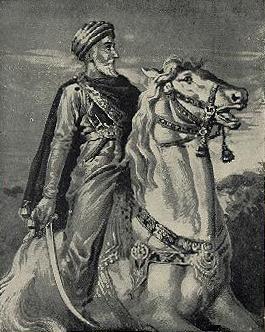"The Assassins were a radical group of Shi'ite Muslims who practiced terrorism against their enemies. If a leader, usually Muslim, opposed them, they murdered him. In 1173, the Old Man of the Mountain, leader of the Assassins, sent a peace envoy to Amalric, the Crusader King of Jerusalem, proposing an alliance. On his way back from the conference with the King, the Assassin envoy was attacked and killed by a band of Templars who were led by a one-eyed knight named Walter de Mesnil. What was the background of this event?
King Amalric demanded De Mesnil's arrest, but Eudes de Saint-Amand, the Master of the Temple at the time, refused, saying that he would send De Mesnil to the Pope for judgment, instead. Amalric had De Mesnil arrested, anyway, but died before he could take the matter further. The regent to his successor, Raymond Ill of Tripoli, declined to continue negotiations with the Assassins. Raymond's father had been the victim of the Assassin attack in 1152 which initially provoked the Temple's anger. In response to Raymond ll's murder, the Templars had successfully invaded Assassin territory in northern Syria. For the next century, the Assassins paid tribute to the Templars.
The Templars' motives in this incident with the Assassin enviy are obscured because the main source of this story is William of Tyre, the archbishop who was also the King's chronicler. William, of course, was more interested in presenting the King's side than that of the Templars. He was convinced that the Assassins (who were part of the Shi'ite lsma'ilite sect, and therefore, the sworn enemies of Nur-ad-Din, who was a Sunni Muslim) were interested in converting to Christianity. The idea that the Assassins, who hated the Christians as much as they did the Sunnis, would make a treaty with the Franks seems dubious, to say the least. The Assassins were as devoted to Islam as the most passionate Crusader was to Christianity. When the Assassins finally did choose sides, they made a treaty with Saladin, Nur-ad-Din's successor, and held to it throughout his lifetime.One reason for the Templars' hostility to the treaty with the Assassins stems from the fact that it would have severely weakened their position in northern Syria. At this time, the Templars owned lands on three sides of the Assassin territory. The Assassins were also paying a tribute of 2,000 Bezants to the Order. As a group which would exist indefinitely, and in which any individual (even the Grand Master) was dispensable, the Templars (and the other military orders) were uniquely immune to the Assassins' tactics of political assassination. The mutual hatred between Assassin and Templar indicates that the Assassins learned this imperviousness of the Order to terrorism through experiment.
Lacking more military methods of persuasion, the Assassins hoped that Amalric might force the Templars to lift their tribute, and Amalric was amenable to the suggestion. If the Assassins reneged on the proposed treaty, it would be the Templars who would suffer, not Amalric. The Templars almost
certainly knew this, and Amalric's secrecy about the treaty (as well as the previous bad blood between the King and the Templars) would only have increased their suspicions."
This blog quotes, with minor adaptations, from pages 29-31 of Stiles, Paula Regina, "BETWEEN TWO FAITHS: THE ARABIZATION OF THE KNIGHTS TEMPLAR DURING THE CRUSADES" (1999). Open Access Master's Theses. Paper 1805. The top illustration shows Hassan-i Sabbā or Hassan as-Sabbāh (c. 1050 – 12 June 1124), the founder of the Nizari Isma'ili state and its fidā'i military group known as the Order of Assassins. Since Marco Polo he has been known in the West as the Old Man of the Mountain. He later seized a mountain fortress called Alamut, source Wikipedia. The bottom illustration shows a map of the Crusader states, showing the area controlled by the Assassins around Masyaf, slightly above the center, in white, source Wikipedia.
Support TemplarsNow™ by becoming a Patron, tipping us or buying one of our Reliable Book


No comments:
Post a Comment